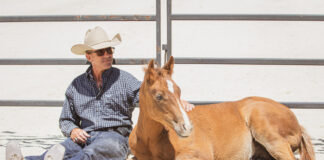One popular myth among equestrians is that a horse’s whorl—the swirling pattern of hair growth on the forehead—can predict a horse’s personality. You may have heard riders swear that a high whorl indicates a hot-tempered horse or that horses with a double whorl are hard to train.

In one study published earlier this month in the Journal of Equine Veterinary Science, researchers at Colorado State University tested a group of 19 horses to see how they would respond to the novel stimulus of an umbrella being opened suddenly. What they found was a correlation between facial hair whorl direction and the direction in which the horses spooked. Horses with clockwise whorls were more likely to turn right and those with counterclockwise whorls were more likely to turn left.
This may seem like a frivolous study—what can the average horse owner do with this information? Interestingly, it might relate to a horse’s sidedness, or the direction in which they prefer to travel. A 2008 study in Ireland used more than 200 horses to study whorls and sidedness. They found that the vast majority of left-dominant horses had counterclockwise whorls and the right-dominant horses were more likely to have clockwise whorls. Read more about this research here.
Noting your horse’s whorl direction might give you some insight into which direction he will prefer (and if you do find that he has a strongly dominant side, check out these exercises to help get him balanced.)
The current Colorado State study noted no significant correlation between whorl location and direction preference. However, past studies with both horses and bulls have noted some connection between whorl location and behavioral traits. There is a possible biological reason behind the connection. Animal behavior expert Dr. Temple Grandin, who was involved in the current study as well as past research on the topic, suggested that whorl location might be related to embryonic brain development. Read more about that here.
Take a look at the horses at your barn and see if you notice any trends related to whorl pattern and location, and let us know what you find.
Behavioral laterality and facial hair whorls in horses
Shivley, Chelsey; Grandin, Temple; Deesing, Mark
Journal of Equine Veterinary Science, March 09, 2016





